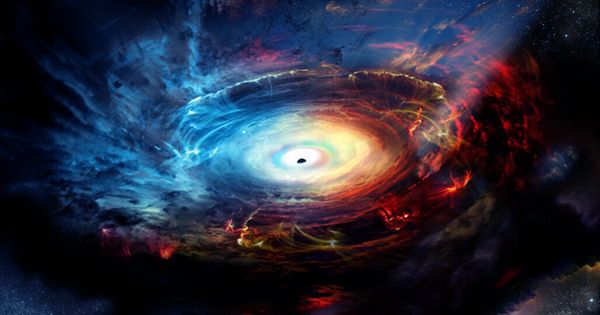EPFL researchers have discovered a way to leverage the phenomena of intense gravitational lensing to measure the mass of a galaxy harboring a quasar with precision—about three times more precise than any other technique—as well as its history in cosmic time. Knowing the mass of quasar host galaxies provides information about the evolution of galaxies in the early universe, which may be used to build scenarios of galaxy formation and black hole formation. The findings have been reported in Nature Astronomy.
“The unprecedented precision and accuracy achieved with gravitational lensing provide a new avenue for obtaining robust mass estimates in the distant Universe, where conventional techniques lack precision and are susceptible to biases,” says senior author of the study EPFL astrophysicist Frédéric Courbin.
“The masses of host galaxies have been measured in the past, but thanks to gravitational lensing, this is the first time that the measurement is so precise in the distant universe,” says lead author Martin Millon, who is presently at Stanford University on an SNF grant.
Combining gravitational lensing and quasars: A quasar is a brilliant manifestation of a supermassive black hole at the heart of a host galaxy that accretes surrounding matter. It is difficult to determine the mass of a quasar’s host galaxy because quasars are very distant objects and also because they are so bright that they overshadow anything in their vicinity.
The mass of the lensing object can be calculated via gravitational lensing. We know how big objects in the foreground of the night sky—the gravitational lens—can bend light emanating from background objects according to Einstein’s theory of gravitation. The weird rings of light that appear are actually gravitational lens distortions of the background object’s light.
More than a decade ago, Courbin was cycling to the Sauverny Observatory when he realized he could combine the two—quasars and gravitational lensing—to determine the mass of a quasar’s host galaxy. He needed to find a quasar in a galaxy that also functions as a gravitational lens for this.
A handful of gravitational lensing quasars observed so far: The Sloan Digital Sky Survey (SDSS) database was a fantastic place to look for gravitational lensing quasar candidates, but Courbin needed to observe the lensing rings to be sure. In 2010, he and colleagues commissioned Hubble Space Telescope time to observe four candidates, three of which showed lensing. SDSS J0919+2720 is distinguished among the three because of its distinctive gravitational lensing rings.
The HST image of SDSS J0919+2720 shown here shows two bright objects in the foreground that operate as gravitational lenses, “probably two galaxies in the process of merging,” according to Corbin. The one on the left is a brilliant quasar within a host galaxy that is too faint to be seen. Another galaxy, the main gravitational lens, is visible on the right. A partner galaxy is a dim object on the far left. The distinctive rings are caused by distorted light from a background galaxy.
Computational lens modeling to the rescue: In theory, the mass of the two brilliant objects can be determined by carefully examining the gravitationally lensed rings in SDSS J0919+2720. Disentangling the masses of the various objects would have been difficult if co-author Aymeric Galan, who is currently at the Technical University of Munich (TUM) on an SNF grant, had not recently developed a wavelet-based lens modeling technique.
“Understanding how a supermassive black hole forms is one of the most difficult problems in astrophysics,” Galan says. “Knowing its mass, how it compares to its host galaxy, and how it evolves over cosmic time allows us to reject or validate certain formation theories.”
“We observe in the local universe that the most massive galaxies also have the most massive black holes at their centers.” This could imply that the amount of energy released by a galaxy’s central black hole and pumped into the galaxy controls its expansion. “However, in order to test this theory, we must study these interactions not only locally, but also in the distant universe,” Millon explains.
Gravitational lensing occurrences are extremely rare, with only one galaxy out of a thousand exhibiting the phenomena. A quasar operating as a lens is one in a million, given that quasars are seen in around one in every thousand galaxies. The ESA-NASA project Euclid, which will be launched this summer with a Falcon-9 SpaceX rocket, is expected to identify hundreds of these lensing quasars.











